
Kramer the labradoodle soothes students, staff at Wauseon Middle School
4/20/2014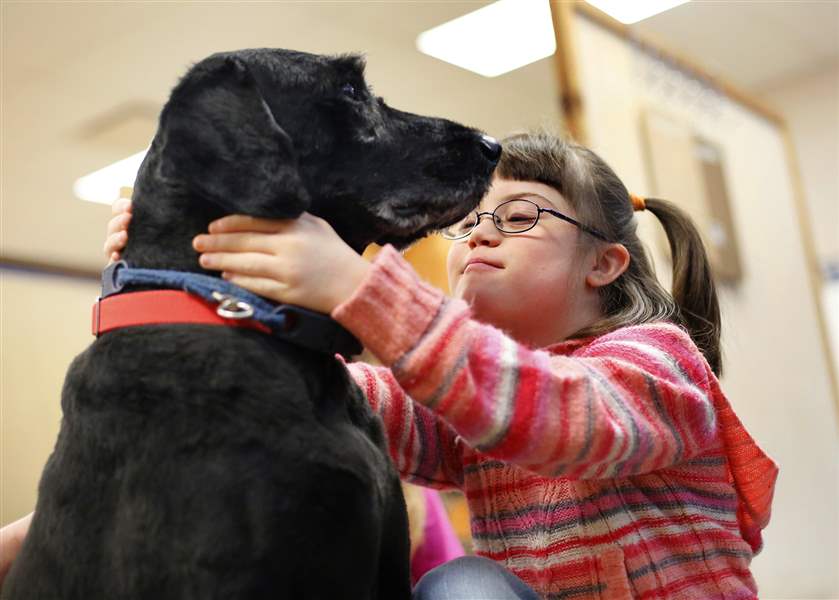
Janae O’Neal, 9, strokes Kramer, the resident pooch at Wauseon Middle School who spends his days visiting offices and classrooms.
The Blade/Amy E. Voigt
Buy This Image
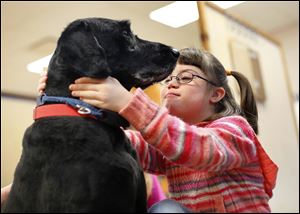
Janae O’Neal, 9, strokes Kramer, the resident pooch at Wauseon Middle School who spends his days visiting offices and classrooms.
WAUSEON — Once upon a time there was a dog that went to middle school.
He was a smart dog, a kind dog, a therapy dog in the service of students who needed friendship, affection, or maybe just a gentle nudge to get them out of their shell.
The school’s principal saw the dog’s effect everywhere he looked: Autistic students began to bloom in his presence. Students who had difficulty reading stroked his fur as they struggled to sound out words. And otherwise perfectly normal kids made time to hug him in the halls and shouted his name when he attended sporting events with his handler.
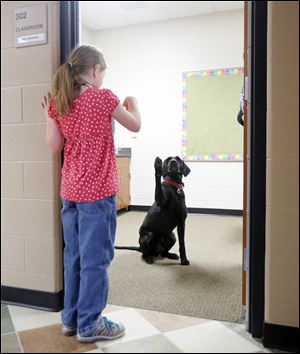
Alyssa Freshour, 9, and Kramer wave goodbye to each other.
That dog is 9-year-old Kramer, and his forever family is an entire middle school.
The 70-pound Labradoodle with playful brown eyes is the big canine on campus at Wauseon Middle School in Fulton County. Whether greeting visitors or sitting with students in the library, he seems as integral to the daily life of the school as the bells that signal the change of classes.
In 2005, Wauseon principal Joe Friess read about a program that placed service dogs in schools and he sought his superintendent’s and school board’s permission to apply. Research has shown the benefits of animal visits to nursing home residents and hospices, while further studies have suggested that pets increase the lifespan and lower the blood pressure of their owners.
What could it hurt?
“He was not brought in for the benefit of one particular student; he was brought in to help the general climate,” Mr. Friess said during a visit to the school. “It’s what he doesn’t provide that’s most important: He doesn’t provide any judgment. I like all my kids, but I get frustrated as heck with them sometimes. We’re all human and he’s not. He just takes everybody at face value. He doesn’t care if you’ve been tardy 10 times. He’s as happy to see you today as he was a week ago.”
As the school’s speech language pathologist, Bobbie Simpkins makes ample use of Kramer’s soothing presence.
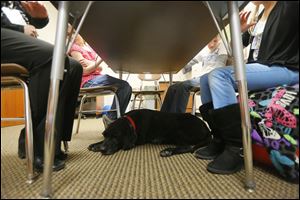
Kramer takes a nap under a table during a speech and language session.
“I [work with] a lot of autistic students and they sometimes have trouble expressing themselves,” Ms. Simpkins explained. “They think it’s easier to talk to Kramer than to me. I find out what they’re thinking or how they came up with an answer because they more or less tell it to Kramer.”
Kramer has the run of the school when accompanied by someone trained to handle him (he understands more than two dozen commands), except, because of health codes, the lunch room. He’s also trained in attributes most dog owners would welcome: he doesn’t bark or jump on people and is very gentle with the neighboring preschool class to which she sometimes takes him. If preschoolers can’t terrorize an animal, no one can.
And being a Labrador retriever-poodle hybrid, he doesn’t shed.
The school got Kramer from Sylvania-based nonprofit Assistance Dogs for Achieving Independence (ADAI), which specializes in training canines to aid people with disabilities. Not all dogs are suitable for such work, yet they have the temperament to be of some service. Many of them are “adopted” out through ADAI’s School Therapy Dog program. There’s usually a multiyear waiting list and the animals can cost upwards of $17,000.
“Some kids think that when everyone goes home he gets put in a closet and gets let out the next morning,” Mr. Friess says with a smile. “But he comes and goes with me. I’m his primary handler so I make sure he gets fed” and groomed.
If Kramer is at Wauseon Middle School for the good times, he’s perhaps even more valuable during the bad ones.
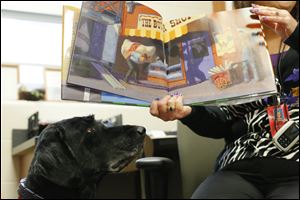
Kramer sits with students listening to a story in a speech and language session at Wauseon Middle School.
“We had a terrible accident a couple of years ago where a student of ours was killed (off campus) with a firearm,” the principal recalled. “We were in school when news of the accident broke, and Kramer was very important that day. If kids don’t know what to say, sometimes they just want to hug him around the neck and whisper something to him and then leave.”
“His job, really, is to be everybody’s pet.”
The dog is also something of a magician.
“He’s made me invisible, which is not a bad thing sometimes,” Mr. Friess says. “I’ll be walking along with him and people will say ‘Hey Kramer!’ And I’m like, what about the person on two feet walking right beside him?”
Contact Mike Pearson at: mpearson@theblade.com or 419-724-6159.